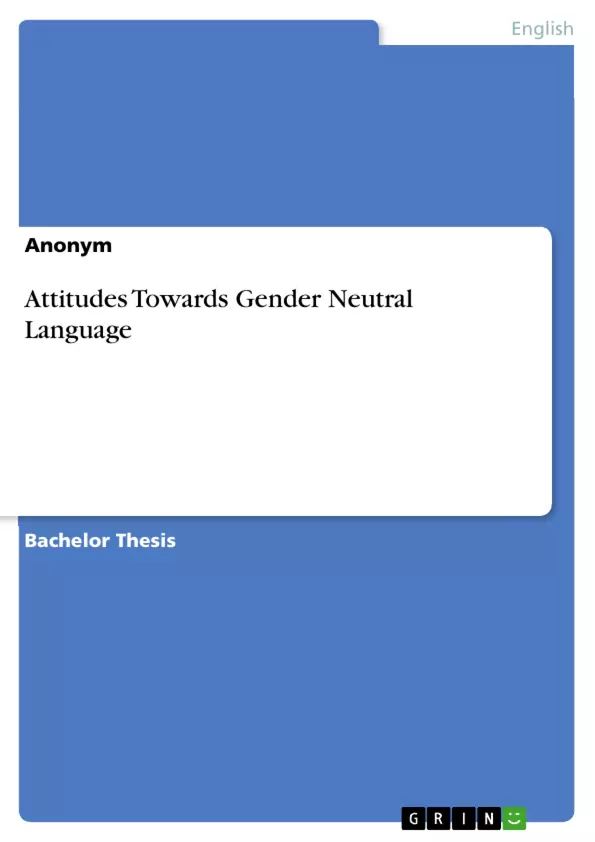This paper aims to investigate attitudes towards gender-neutral language in Germany. The two hypotheses that are put forward are that firstly, females are more open to gender-neutral language than males, and secondly, younger people are more open to gender-neutral language than older people. A survey was distributed through Facebook and other social media channels to gather data about the different attitudes that resulted in 146 valid answers. Furthermore, the participants were divided into four generations and the genders male, female, and divers. After comparing the different groups, the two hypotheses could both be verified.
Inhaltsverzeichnis (Table of Contents)
- Introduction
- Theoretical Background: Language, Identity and Gender
- Identity
- Identity and Language
- Gender Identity
- Gender-Neutral Language
- Gender Neutral German
- Related Studies and Criticism
- Women as leaders of linguistic change
- Method
- Results and Discussion
- Comparison of males and females
- Comparison of Generations
- Attitudes of non-binary individuals
- Limitations and Criticism
- Conclusion
Zielsetzung und Themenschwerpunkte (Objectives and Key Themes)
This paper aims to investigate attitudes towards gender-neutral language in Germany. The two hypotheses that are put forward are that firstly, females are more open to gender-neutral language than males, and secondly, younger people are more open to gender-neutral language than older people.
- The impact of gender-neutral language on individuals and society.
- The relationship between language, identity, and gender.
- The development and implementation of gender-neutral language in Germany.
- The attitudes of different generations towards gender-neutral language.
- The role of women in promoting linguistic change.
Zusammenfassung der Kapitel (Chapter Summaries)
- Introduction: This chapter discusses the current debate surrounding gender-neutral language, highlighting the importance of recognizing the distinction between sex and gender. It explores the potential benefits of using gender-neutral language while acknowledging existing criticisms. The chapter focuses on the specific challenges and opportunities of implementing gender-neutral language in German.
- Theoretical Background: Language, Identity and Gender: This chapter provides a theoretical framework for understanding the relationship between language, identity, and gender. It delves into the concepts of identity, gender identity, and the influence of language on both. The chapter also examines the development of gender-neutral language globally and specifically in German, including related research and critiques. It highlights the crucial role of women in driving linguistic change.
- Method: This chapter outlines the methodology employed in the study. It describes the data collection process, including the online survey used to gather information about attitudes towards gender-neutral language.
- Results and Discussion: This chapter presents the findings of the study, analyzing attitudes towards gender-neutral language across different gender groups and generations. It delves into the comparison between males and females, the perspectives of different generations, and the views of non-binary individuals.
Schlüsselwörter (Keywords)
This study focuses on the attitudes towards gender-neutral language in Germany, particularly examining the differences between genders and generations. Key concepts explored include identity, gender identity, the influence of language on identity, and the implementation of gender-neutral language in German.
- Quote paper
- Anonym (Author), 2022, Attitudes Towards Gender Neutral Language, Munich, GRIN Verlag, https://www.grin.com/document/1359143



